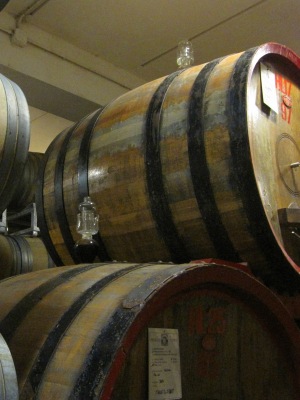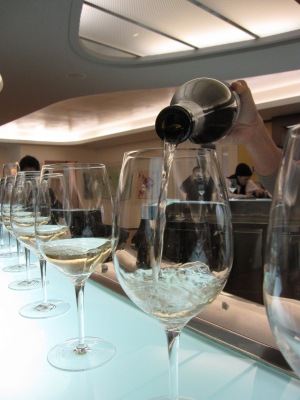“This is one of the most important products in the panorama of Italian wines. Are you familiar with it?” I was haplessly ignorant as Eleonara Marzi began her presentation on sagrantino wines. Over the next week though, we would drink the hometown favorite of Umbria more times than I could remember.
Sagrantino is a native grape variety that has been cultivated in Montefalco for over 400 years, and sagrantino secco is recognized as a DOCG wine indigenous to Umbria. However, until the 1970s, most Umbrian wineries focused on producing merlot and cabernet sauvignon. Sagrantino was mostly relegated to the production of passito, or sweet dessert wines. This was due in part to the intensity of sagrantino grapes, which are higher in tannins and polyphenols than any other grape. To combat the persistence of the tannins, farmers generally added sugar to increase the softness of the wine and make it more drinkable.
In the winemaking world, the Arnaldo Caprai winery is credited with promoting and elevating sagrantino to the vaunted world-famous status it holds today. After the phylloxera fungal plague of the 19th century, most sagrantino vines died out and only a few hectares remained under cultivation. Through their collaboration with the University of Milan, the winery selected and propagated the best sagrantino clones, while retaining variability within the sagrantino variety, thereby safeguarding an important part of Italian ampelography. Plants were tailored to match the soil composition, microclimate and altitude of their vineyard.
Like the rest of the Umbrian countryside, olive trees dot the landscape at the Caprai vineyard, and workers were energetically harvesting the remaining fruit before the approach of frost. In addition to their line-up of wines, Arnaldo Caprai also offers olive oil pressed from moraiolo, frantoio and leccino olives. We were just in time to taste olive oil that was freshly pressed one week earlier. Drizzled over a slice of toasted bread, the oil was a striking grass-colored shimmer with a mild peppery pungency.
About 150 hectares of vineyards comprise the Caprai estate, and 30 hectares of that is used for experimentation, an innovative focus unique to the winery. In these fields, you can see research taking place in trellis system design, plant density and sustainable management practices. Of course, not every experiment yields successful results. Pictured above is a new V-shaped trellising system, with double the surface area for vine exposition. While the design works well here, it cannot be used in hilly areas, since there isn’t enough room for tractor equipment to maneuver around the plants. In an adjacent field, a low trellising system was in place, with vines placed closer than normal to the ground. The concentration of polyphenols was higher with this type of trellis, but there were increased fungal problems due to the proximity to the ground.
Caprai also strives to employ ecologically friendly production practices, with minimal use of sulfites and pesticides. Control grass between the vines is used to promote moisture retention and reduce erosion. It also creates healthy environmental competition between the grapes and the grass.
Arnaldo Caprai produces grechetto whites, montefalco rosso (70% sangiovese, 15% sagrantino, 15% merlot), montefalco sagrantino, and a 25th anniversary sagrantino that they first produced in 1993 to mark their quarter-century anniversary and have since continued producing despite the misleading title. With the leftover sagrantino skins, they produce grappa. Harvest season begins in early September with picking the grapes, followed by stem and leaf removal, and hand selection of inferior grapes out of the general pool. Then, the grapes are crushed and fermentation begins in stainless steel tanks.
Stainless steel tanks are used to age white wines to better maintain their acidity, but red wines are aged in French oak or 15-year-old Slovenian casks. (Amusingly, Caprai procures some of their French oak casks from François Frères tonnellerie.) The forceful, tannic personality of Sagrantino means it requires a long maturation, and can be aged for 20 years or more, at which point the tannins have smoothed.
At the top of the wine tanks, there are glass tappo colmature, or topping-off caps. These glass bottles are used to keep the barriques full, since the volume of the liquid inside expands and shrinks as the wine ages and the oak absorbs it.
Returning to the Caprai enoteca, we gathered for a taste of the 2009 Grecante Grechetto dei Colli Martini DOC. Crisp, fruity and floral, the class was quite disappointed to learn that Caprai had just served us their last six bottles and thus we could not buy some to bring home. Next, a stream of deep blood-red pours, a reminder of sagrantino’s original use in religious rites (the name is derived from “sacrament”). Sagrantino boasts a rich ruby red, almost black color, thanks to its extremely thick skin and few seeds. In contrast, pinot noir has thin skin and lots of seeds. The 2007 Montefalco Rosso that we tried was pleasantly fruity and perfumed with vanilla, but was certainly one of the most astringent reds I have ever tasted, leaving a dry pucker on your tongue like a persimmon peel. We later tried a longer-aged 25th year Sagrantino, in which the tannins had settled more elegantly. The robust flavors paired quite well with the hearty, pork-heavy cuisine of Umbria.
From obscurity and near-extinction to worldwide distribution, sagrantino has secured a permanent place in enological history. Be sure to check it out at your local wine shop for the upcoming winter season.








